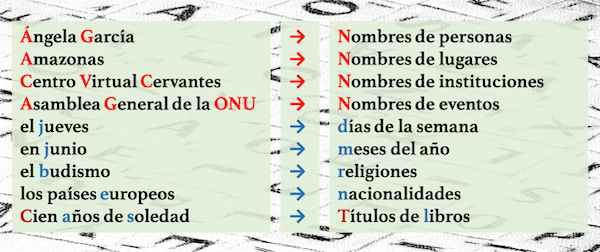05. Uso de las mayúsculas / Use of capital letters
( \newcommand{\kernel}{\mathrm{null}\,}\)
 |
|
|
Como en inglés, en español tienen mayúscula inicial los nombres propios de personas (Juan, Ángela, García, Afrodita, Géminis), lugares (Panamá, San Francisco, Amazonas, los Andes, Saturno, Plaza Sésamo), instituciones (Universidad de Salamanca, Museo de Arte Moderno) y eventos oficiales (Congreso de Antropología, Día de la Independencia, la Feria del Libro). |
Like English, Spanish capitalizes proper names for people (Juan, Ángela, García, Afrodita, Géminis), places (Panamá, San Francisco, Amazonas, los Andes, Saturno, Plaza Sésamo), institutions (Universidad de Salamanca, Museo de Arte Moderno), and official events (Congreso de Antropología, Día de la Independencia, la Feria del Libro). |
Sin embargo, hay varios grupos de palabras que se escriben con minúscula en español y con mayúscula en inglés. Se escriben con letras minúsculas:
|
There are, however, several groups of words which Spanish writes in lowercase while English uses capital letters. Do not capitalize:
|
| Para los títulos de libros, películas, etc., generalmente se escribe con mayúscula solamente la primera palabra (y cualquier nombre propio, claro): Informe semanal Guía para la exploración del Amazonas Las cuatro estaciones |
In titles (of books, movies, etc.), only the first word and any proper nouns are generally capitalized: Weekly Report A Guide to Explore the Amazon The Four Seasons |
A. Escriba en español los siguientes títulos:
1. Uncle Tom's Cabin
2. A Hundred Years of Solitude
3. One Day in Paradise
4. A Guide to Visit Buenos Aires
B. Reescriba el siguiente texto, incluyendo las mayúsculas y las tildes cuando sean necesarias.
|
"el señor juan valdez esta claramente asociado con el cafe colombiano a causa de la publicidad que la federacion nacional de cafeteros de colombia ha utilizado durante años. recuerdo que, en mi niñez, lo veia todos los miercoles durante mi programa favorito, plaza sesamo, y me preguntaba como podia el mantener el delantal siempre tan limpio". |
"Mr. Juan Valdez is clearly associated with Colombian coffee because of the publicity that the National Federation of Coffee Growers in Colombia has used for years. I remember that, in my childhood, I used to see him every Wednesday during my favorite program, "Sesame Street," and I wondered how he was able to always keep his apron so clean." |
- Respuestas
-
- 1. La cabaña del tío Tom 2. Cien años de soledad 3. Un día en el paraíso 4. Guía para visitar Buenos Aires
- "El Sr. Juan Valdez está claramente asociado con el café colombiano a causa de la publicidad que la Federación Nacional de Cafeteros de Colombia ha utilizado durante años. Recuerdo que, en mi niñez, lo veía todos los miércoles durante mi programa favorito, Plaza Sésamo, y me preguntaba cómo podía él mantener el delantal siempre tan limpio".


